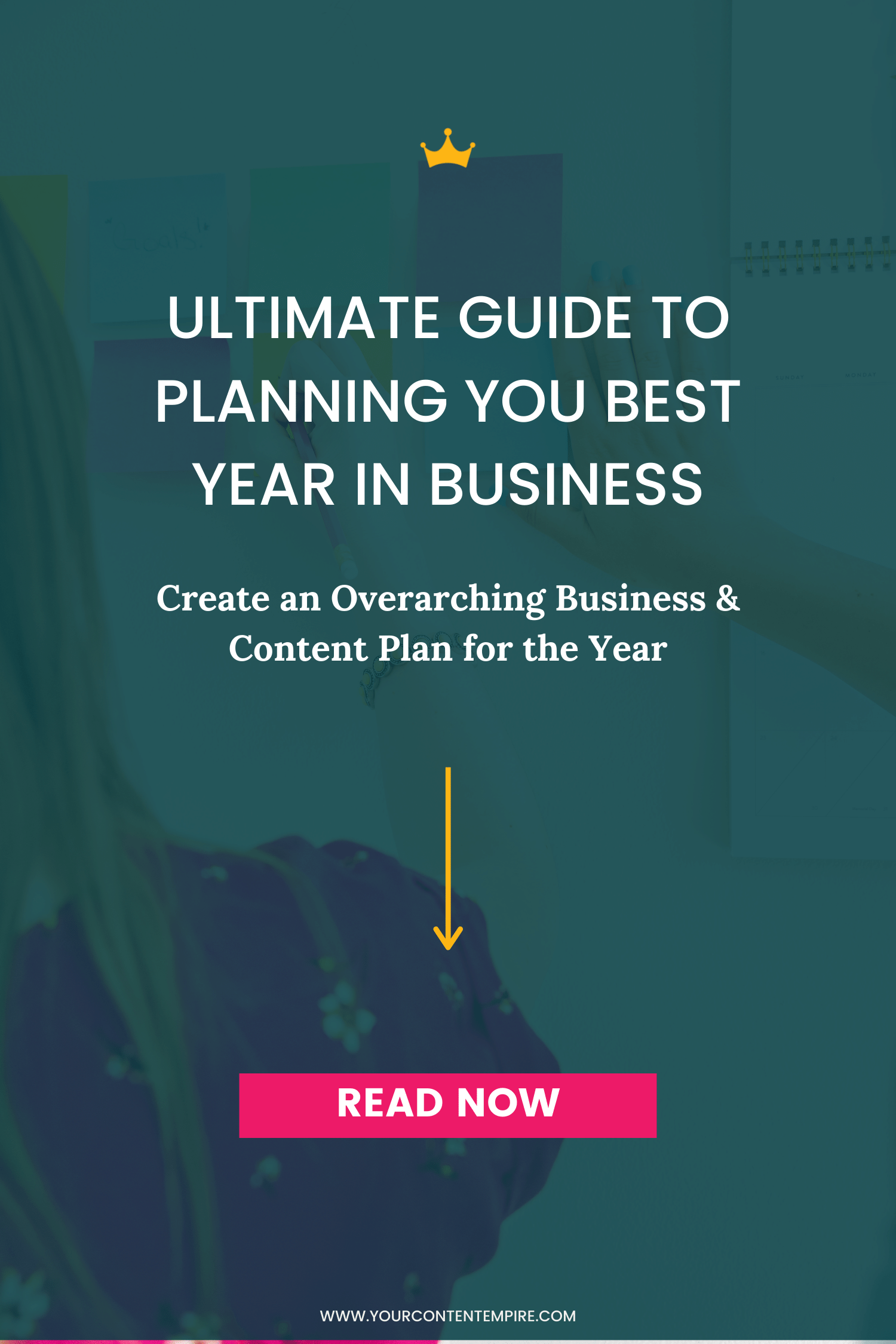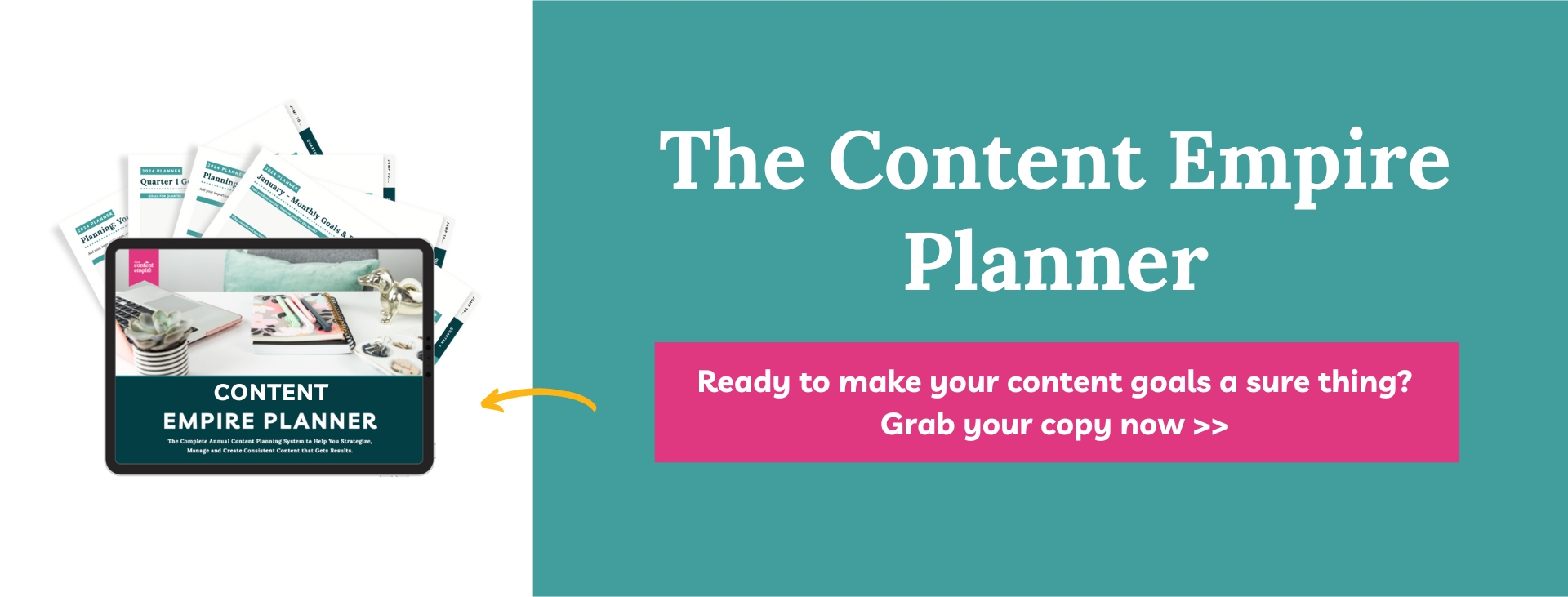I’m so excited to have you back for Part 2 of the “Planning Your Best Year in Business Yet” Guide!
In Part 1, we completed a pretty in-depth audit and reflection of our previous year, going through each area of your business.
You might have had some ideas come up on things that you want to maybe change or optimize for next year, so keep that list handy and make sure you have it in front of you for this part of the planning process.
It’s really important to complete the audit and review process (Part 1) because there’s so much that you can learn from your business and bring forward to improve upon in the next year. This isn’t a total overhaul process by any means, but it is this constant refinement and tweaking process for your business.
In this part, I’m building upon what we talked about in part 1, starting to focus on the ACTUAL planning, coming up with goals and detailing out project plans, as well as putting some implementation support into place.
Phase 1: Start with Planning
Step 1: Dream
I start off with dreaming (because why not?!), and come up with as many goal ideas as possible for my business. I try not to limit or filter myself, spending at least 30 minutes on journaling out my dreams, writing down different ideas, maybe pulling things from Part 1 or jotting down things I’ve been thinking about for a while.
I use Power Sheets from Cultivate What Matters, where I continually jot things down, so I usually have some ideas of what goals that maybe didn’t get done last year that I’d like to move forward. This process is really just a giant mass of ideas written down so that I can empty my head.
Step 2: Evaluate the Goals
In this step, I’m taking all of those dreams and goals and putting them in a list form. I might not be making choices yet of which one I’m going to move forward with, but I’m making a clear list of what each goal actually is. I usually have anywhere from ten to 30 ideas, which is WAY too much to tackle in one year, so I begin to rank them.
When I’m ranking them, I use a table like the one pictured below.

I also cover this ranking process in my Ultimate Goal Setting Guide, which you can check out if you haven’t already.
What I’m doing here is creating an evaluation matrix:
- How badly do I want this goal for my business?
- How essential is it that I do it right now?
- How big of an impact is this going to have on my business?
- How much am I willing to pay for it in terms of money, time, effort, and energy?
Give each goal a score of 1 to 10, and then tally up the score for each of your ideas, ranking them 1, 2, 3, 4, 5, etc. based on what has the highest score.
Step 3: Quarterly plan
Now that I have an actual list of goals, and I know which ones I need to tackle next year, it’s time to plan them out into actionable quarters. I break my goals up by quarters of the year, compartmentalizing them in their own three-month block. That doesn’t necessarily mean this is the ONLY thing I’m working on during that quarter, in fact, they might only be a one-month goal, but I allocate them so that I can visually make sure I don’t have more than five goals in a quarter.
You might also find while doing this process that there are some goals that need to get done before others can get started, even if that one goal was ranked higher than the other in your evaluation process. This is a bit of a tweaking process, putting things down, moving them around as needed, so be prepared to make a mess here!
You can get the goal planner template in the quarterly section of the Content Empire Planner.
Step 4: Revenue planner
This is where I create a really high-level revenue plan for the year, looking at those numbers we pulled in Part 1 of the planning guide and deciding what my stretch goal is going to be, and what my good, better, best goal will be in terms of revenue. I’m also planning how much of each offer I’ll have to sell in order to reach those goals, coming up with the number of units for each service package or digital product I have.
Breaking it down, I usually base these units off of how I did in the previous year. If it’s a new offer, I base it off something that might be similar.
It’s totally okay if you don’t have a bunch of historical data to go off of. While this might feel like a guessing game for you this time around, you’ll have this next year to go off of when planning for next year.
If you’re in this phase of setting a baseline year, you can list all of your offers and put your revenue goal next to them, taking the best guess at how many units of each offer you need to sell to get you there. It might not be an exact equation, but it will give you an idea so we can move onto our next step.
Step 5: Sketch each month
The next thing I do is sketch out each month for the coming year in more detail. I have my quarterly goal plan and I already know what my revenue goal is, so when I sketch each month I make sure to keep it high level.
So much can change between now and when each actual month of next year shows up, so I don’t actually plan out the action plans behind each goal until the quarter sections of the planner.
Our whole purpose in this dreaming and planning phase is to set the compass of where we want to go the following year, allowing me to devise a couple of promotional focuses for each month ahead of time:
- What is one thing that I’m focused on selling?
- What is a business activity that I have going on?
- What are my topic ideas for this month?
I want to have a pretty good idea of what those things are going to be, even if they’re going to shift a bit when the month actually arrives. I’ll further refine and solidify each plan as the quarter actually approaches.
By the time I’m done this planning phase, I know what my goals are, what I’m going to be focusing on each quarter, and what my high-level revenue plan is. I also have a high-level monthly plan so I know what might be going on marketing and promotional wise.
Phase 2: Implementation Support
I like to do a couple of things that are going to set me up for success in the following year to keep my motivation high. I dive into my Power Sheets, which I get every year from Cultivate What Matters, and I move my high-level goals into there, making sure I’m setting a couple of personal goals as well.
Because we’re PEOPLE, not just business owners.
Step 1: Create a vision statement
I usually create some kind of vision statement to encompass the coming year. Something that I can grasp onto when I read it, or share when I’m doing my weekly board or review meetings with my team.
Sometimes I create a vision board alongside this statement, putting it on the background of my iPad so that I can see it all the time. This is also a super fun way to wrap up your solo planning retreat!
Step 2: Build a content workflow
Finally, I update my content workflow. We did a BUNCH of planning in Part 1 of this process, which may have made room for some new channels you want to explore.
Maybe you’ve decided you want to launch a podcast or a YouTube channel? Most of those ideas that you came up with the other day are beginning to be solidified during this phase.
You can check out my Quarterly Content Workflow here to get you started on building out your content, and know that these ideas can change as you work through your solo business retreat.
You’re Almost Ready to Start Planning…
Don’t forget to grab the Content Empire Planner so you can strategize, manage, and create consistent content that gets results.







